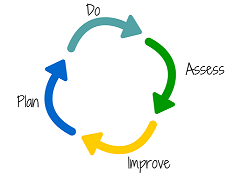Accreditation: Step-by-Step
Whether a program has just passed the eligibility phase, or is seeking reaccreditation, the self-study process supports program growth as they conduct a holistic self-evaluation of mission-based success. What are your goals? What are your strengths? Your opportunities? Your successes? By focusing on programmatic mission and outcomes, the self-study process hands programs the tools needed to distinguish themselves and tout program accomplishments.
Programs seeking (re)accreditation are continuously:
- pursuing their mission and goals,
- engaging with stakeholders,
- gathering data,
- assessing student learning, and
- evaluating the program.
First time applicants begin the process by first completing an eligibility application, which allows the program to receive formative feedback from the Commission on Peer Review and Accreditation (COPRA). The full accreditation review cycle - which is the same for eligibility reviewed programs and programs seeking reaccreditation - includes the Self-Study Report, interim communication with COPRA, a three-person site visit, and a final accreditation decision. After a program is accredited, it is required to complete an annual accreditation maintenance report each fall. For more detailed information on each of these steps, please see the Accreditation Cycle page.
For the official standards and policies of NASPAA Accreditation, please click here.

